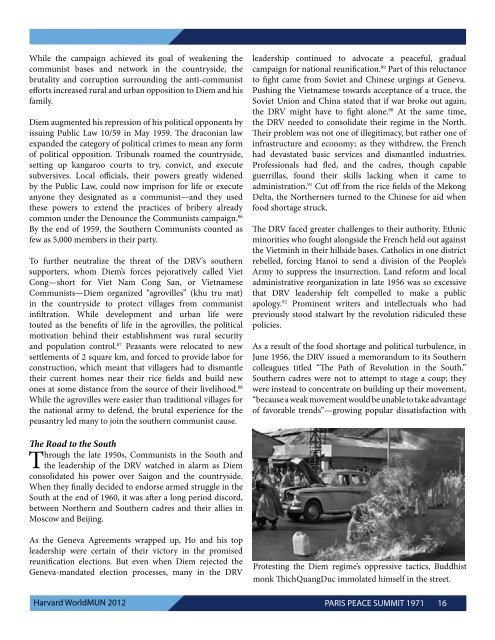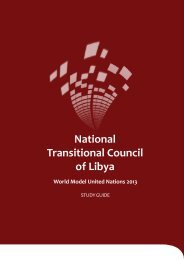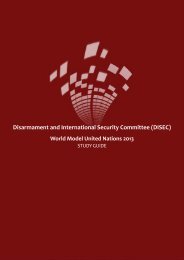Paris Peace Summit, 1971 - World Model United Nations
Paris Peace Summit, 1971 - World Model United Nations
Paris Peace Summit, 1971 - World Model United Nations
Create successful ePaper yourself
Turn your PDF publications into a flip-book with our unique Google optimized e-Paper software.
While the campaign achieved its goal of weakening the<br />
communist bases and network in the countryside, the<br />
brutality and corruption surrounding the anti-communist<br />
eorts increased rural and urban opposition to Diem and his<br />
family.<br />
Diem augmented his repression of his political opponents by<br />
issuing Public Law 10/59 in May 1959. e draconian law<br />
expanded the category of political crimes to mean any form<br />
of political opposition. Tribunals roamed the countryside,<br />
setting up kangaroo courts to try, convict, and execute<br />
subversives. Local ocials, their powers greatly widened<br />
by the Public Law, could now imprison for life or execute<br />
anyone they designated as a communist—and they used<br />
these powers to extend the practices of bribery already<br />
common under the Denounce the Communists campaign. 86<br />
By the end of 1959, the Southern Communists counted as<br />
few as 5,000 members in their party.<br />
To further neutralize the threat of the DRV’s southern<br />
supporters, whom Diem’s forces pejoratively called Viet<br />
Cong—short for Viet Nam Cong San, or Vietnamese<br />
Communists—Diem organized “agrovilles” (khu tru mat)<br />
in the countryside to protect villages from communist<br />
inltration. While development and urban life were<br />
touted as the benets of life in the agrovilles, the political<br />
motivation behind their establishment was rural security<br />
and population control. 87 Peasants were relocated to new<br />
settlements of 2 square km, and forced to provide labor for<br />
construction, which meant that villagers had to dismantle<br />
their current homes near their rice elds and build new<br />
ones at some distance from the source of their livelihood. 88<br />
While the agrovilles were easier than traditional villages for<br />
the national army to defend, the brutal experience for the<br />
peasantry led many to join the southern communist cause.<br />
e Road to the South<br />
Through the late 1950s, Communists in the South and<br />
the leadership of the DRV watched in alarm as Diem<br />
consolidated his power over Saigon and the countryside.<br />
When they nally decided to endorse armed struggle in the<br />
South at the end of 1960, it was aer a long period discord,<br />
between Northern and Southern cadres and their allies in<br />
Moscow and Beijing.<br />
As the Geneva Agreements wrapped up, Ho and his top<br />
leadership were certain of their victory in the promised<br />
reunication elections. But even when Diem rejected the<br />
Geneva-mandated election processes, many in the DRV<br />
leadership continued to advocate a peaceful, gradual<br />
campaign for national reunication. 89 Part of this reluctance<br />
to ght came from Soviet and Chinese urgings at Geneva.<br />
Pushing the Vietnamese towards acceptance of a truce, the<br />
Soviet Union and China stated that if war broke out again,<br />
the DRV might have to ght alone. 90 At the same time,<br />
the DRV needed to consolidate their regime in the North.<br />
eir problem was not one of illegitimacy, but rather one of<br />
infrastructure and economy; as they withdrew, the French<br />
had devastated basic services and dismantled industries.<br />
Professionals had ed, and the cadres, though capable<br />
guerrillas, found their skills lacking when it came to<br />
administration. 91 Cut o from the rice elds of the Mekong<br />
Delta, the Northerners turned to the Chinese for aid when<br />
food shortage struck.<br />
e DRV faced greater challenges to their authority. Ethnic<br />
minorities who fought alongside the French held out against<br />
the Vietminh in their hillside bases. Catholics in one district<br />
rebelled, forcing Hanoi to send a division of the People’s<br />
Army to suppress the insurrection. Land reform and local<br />
administrative reorganization in late 1956 was so excessive<br />
that DRV leadership felt compelled to make a public<br />
apology. 92 Prominent writers and intellectuals who had<br />
previously stood stalwart by the revolution ridiculed these<br />
policies.<br />
As a result of the food shortage and political turbulence, in<br />
June 1956, the DRV issued a memorandum to its Southern<br />
colleagues titled “e Path of Revolution in the South.”<br />
Southern cadres were not to attempt to stage a coup; they<br />
were instead to concentrate on building up their movement,<br />
“because a weak movement would be unable to take advantage<br />
of favorable trends”—growing popular dissatisfaction with<br />
Protesting the Diem regime’s oppressive tactics, Buddhist<br />
monk ichQuangDuc immolated himself in the street.<br />
Harvard <strong>World</strong>MUN 2012 PARIS PEACE SUMMIT <strong>1971</strong> 16
















